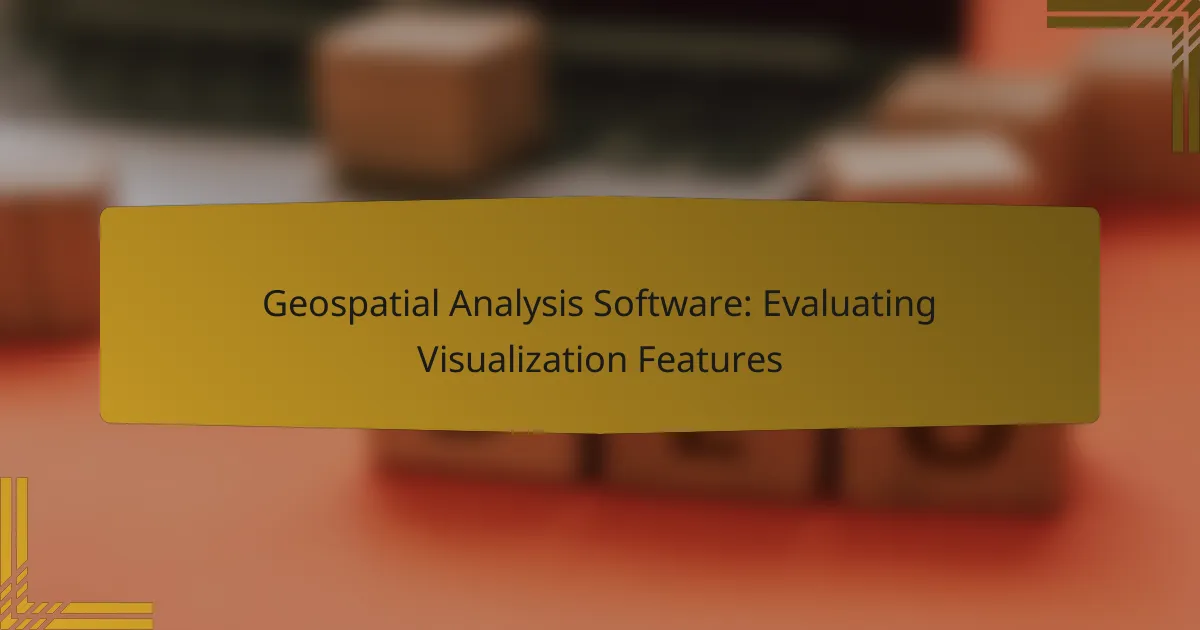Geospatial analysis software plays a crucial role in visualizing complex spatial data, with leading platforms like ArcGIS Online, QGIS, and Mapbox offering distinct features tailored to various user needs. Effective visualization capabilities enhance the interpretability of data, enabling users to uncover patterns and insights that drive informed decision-making. When assessing these tools, it’s essential to consider factors such as user interface design, data integration, and customization options, as they significantly influence the overall user experience and functionality.
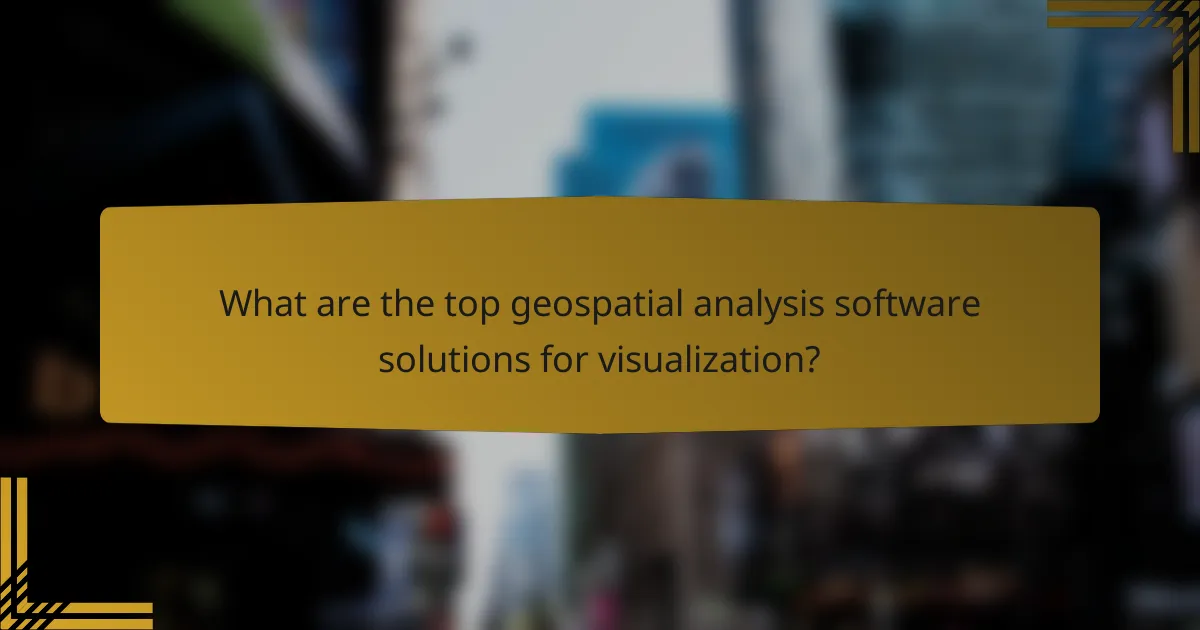
What are the top geospatial analysis software solutions for visualization?
The leading geospatial analysis software solutions for visualization include ArcGIS Online, QGIS, Mapbox, Tableau, and Google Earth Engine. Each platform offers unique features and capabilities tailored for different visualization needs and user expertise.
ArcGIS Online
ArcGIS Online is a cloud-based mapping and analysis tool that allows users to create interactive maps and visualizations. It supports a wide range of data formats and provides robust tools for spatial analysis, making it suitable for both beginners and advanced users.
Key features include customizable templates, real-time data integration, and extensive basemaps. Users can easily share their visualizations with others or embed them in websites, enhancing collaboration and accessibility.
QGIS
QGIS is an open-source geographic information system that offers powerful visualization capabilities. It allows users to create detailed maps using various data sources, including vector and raster formats.
With a user-friendly interface and a wide array of plugins, QGIS supports advanced mapping techniques such as heat maps and 3D visualizations. It is ideal for users looking for a cost-effective solution with extensive community support.
Mapbox
Mapbox is a platform focused on customizable maps and data visualization. It provides developers with tools to create visually appealing maps that can be integrated into web and mobile applications.
Mapbox stands out for its high-quality graphics and real-time data capabilities. Users can leverage its APIs to design unique visualizations tailored to specific needs, making it a favorite among developers and data scientists.
Tableau
Tableau is a leading data visualization tool that excels in transforming complex data into interactive dashboards. While not exclusively a geospatial tool, it offers strong mapping features that allow users to visualize geographic data effectively.
Tableau’s drag-and-drop interface simplifies the creation of maps and visualizations, making it accessible for non-technical users. It integrates well with various data sources, enabling users to analyze spatial trends alongside other data types.
Google Earth Engine
Google Earth Engine is a cloud-based platform designed for large-scale geospatial analysis and visualization. It provides access to a vast archive of satellite imagery and geospatial datasets, making it ideal for environmental monitoring and research.
Users can perform complex analyses using its JavaScript API and visualize results directly in the browser. This platform is particularly useful for researchers and organizations focused on sustainability and land use changes.
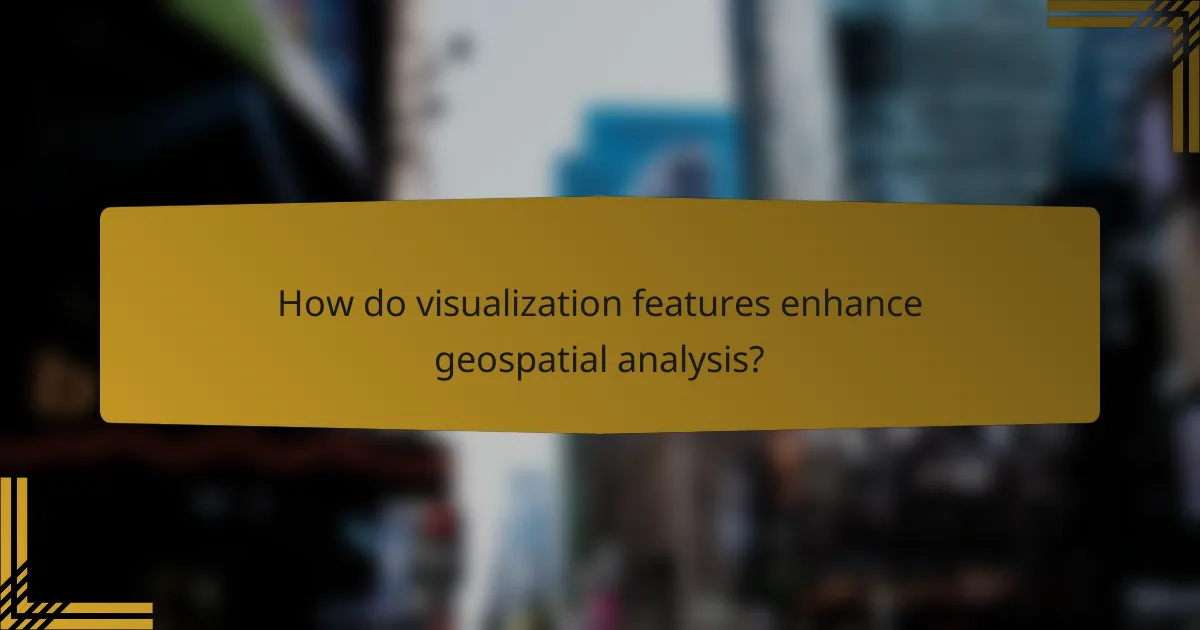
How do visualization features enhance geospatial analysis?
Visualization features significantly enhance geospatial analysis by making complex data more accessible and interpretable. They allow users to identify patterns, trends, and anomalies within spatial datasets, ultimately leading to more informed insights and actions.
Improved data interpretation
Visualization tools transform raw geospatial data into visual formats like maps and graphs, which facilitate easier understanding. By representing data geographically, users can quickly grasp relationships and distributions that may not be evident from numerical data alone.
For instance, heat maps can illustrate population density, highlighting areas of high and low concentration. This visual representation enables analysts to interpret data intuitively, making it easier to communicate findings to stakeholders.
Enhanced decision-making
Effective visualization features support better decision-making by providing clear insights into geospatial data. When decision-makers can visualize potential outcomes, they can evaluate various scenarios and make more strategic choices.
For example, urban planners can use 3D visualizations to assess the impact of new developments on existing infrastructure. This capability allows them to foresee challenges and opportunities, leading to more sustainable urban growth.
Real-time data visualization
Real-time visualization features enable users to monitor geospatial data as it changes, providing immediate insights into dynamic situations. This capability is crucial for applications such as disaster response, where timely information can save lives and resources.
For instance, mapping tools that display real-time traffic conditions can help city planners adjust routes and manage congestion effectively. By leveraging real-time data, organizations can respond swiftly to emerging trends and make proactive adjustments.
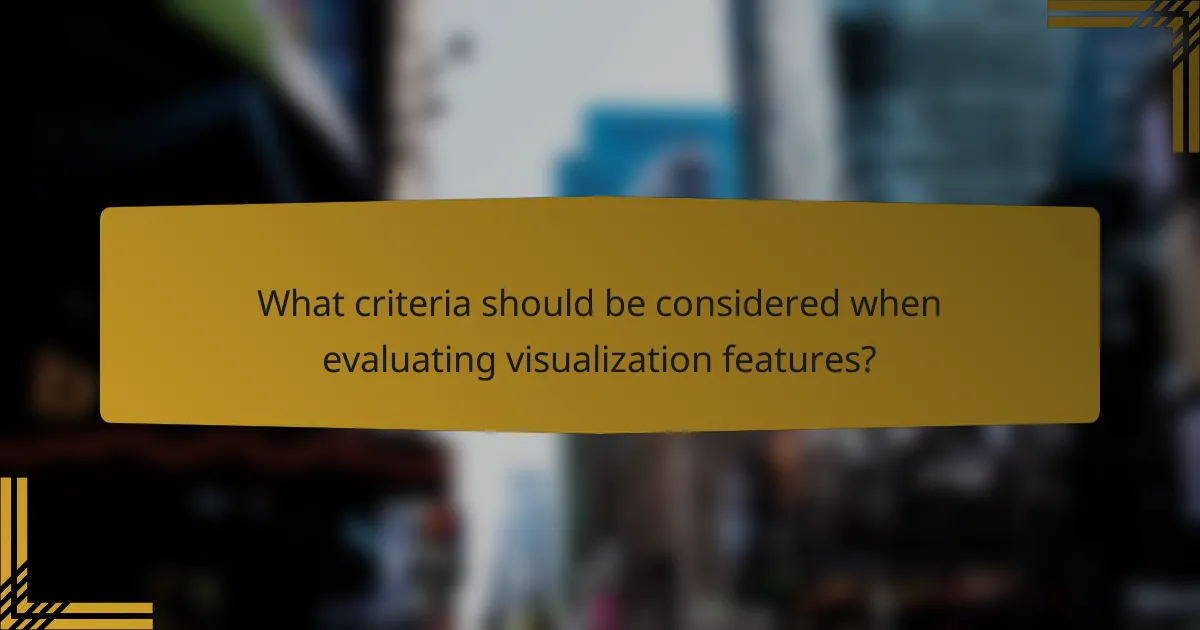
What criteria should be considered when evaluating visualization features?
When evaluating visualization features in geospatial analysis software, consider user interface design, data integration capabilities, and customization options. These criteria directly impact usability, functionality, and the ability to tailor visual outputs to specific needs.
User interface design
User interface design is crucial for ensuring that users can navigate the software efficiently and intuitively. Look for features like drag-and-drop functionality, clear menus, and responsive layouts that adapt to different screen sizes. A well-designed interface minimizes the learning curve and enhances productivity.
Consider the visual hierarchy of elements, as it should guide users to important tools and features without overwhelming them. Simple color schemes and consistent iconography can improve user experience significantly.
Data integration capabilities
Data integration capabilities determine how well the software can combine various data sources, which is essential for comprehensive geospatial analysis. Evaluate whether the software supports multiple formats such as CSV, GeoJSON, and shapefiles, as well as connections to databases like SQL or cloud storage solutions.
Additionally, check for real-time data integration options, which can enhance the relevance of visualizations. The ability to seamlessly integrate diverse datasets allows for more robust analysis and richer visual outputs.
Customization options
Customization options allow users to tailor visualizations to specific project requirements. Look for features that enable users to adjust colors, styles, and layouts easily. The ability to create custom templates can save time and ensure consistency across projects.
Consider whether the software provides scripting capabilities or APIs for advanced users who want to automate tasks or create unique visualizations. Flexibility in customization can significantly enhance the overall effectiveness of the analysis.

What are the pricing models for geospatial analysis software?
Geospatial analysis software typically employs various pricing models, each catering to different user needs and budgets. The most common models include subscription-based pricing, one-time purchase options, and freemium models, allowing users to choose based on their usage patterns and financial considerations.
Subscription-based pricing
Subscription-based pricing is a prevalent model for geospatial analysis software, where users pay a recurring fee, often monthly or annually. This model provides continuous access to the latest features and updates, which is crucial in a rapidly evolving field.
Prices can vary widely, generally ranging from around $20 to several hundred dollars per month, depending on the software’s capabilities and the level of support offered. Users should consider the total cost of ownership over time, as subscriptions can accumulate significant expenses if used long-term.
One-time purchase options
One-time purchase options allow users to buy the software outright, providing a single license for perpetual use. This model can be more cost-effective for users who prefer not to commit to ongoing payments.
However, users should be aware that one-time purchases may not include future updates or support, which could necessitate additional costs down the line. Prices for these licenses typically range from a few hundred to several thousand dollars, depending on the software’s complexity and features.
Freemium models
Freemium models offer basic features at no cost, with the option to upgrade to premium features for a fee. This approach allows users to test the software before making a financial commitment, which can be particularly beneficial for small businesses or individual users.
While the free version may have limitations in functionality or data access, it can still provide valuable insights for users just starting. Upgrading to premium plans usually involves monthly or annual fees, which can vary based on the additional features and capabilities provided.
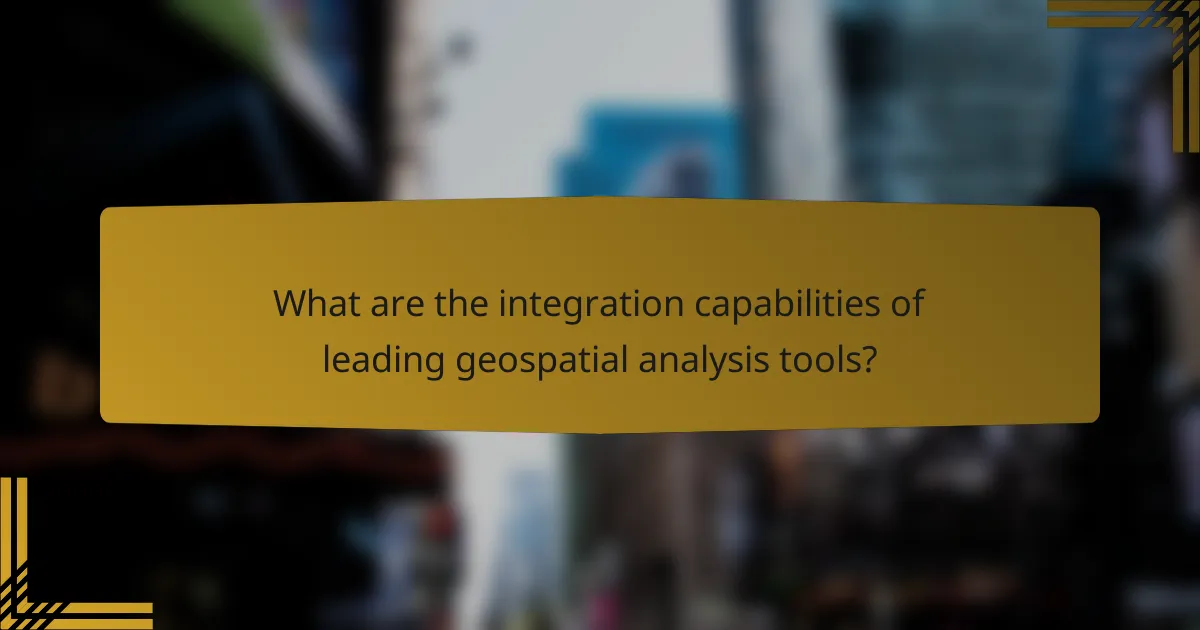
What are the integration capabilities of leading geospatial analysis tools?
Leading geospatial analysis tools typically offer robust integration capabilities, allowing users to connect with various data sources and software applications. These integrations enhance functionality, streamline workflows, and facilitate data sharing across platforms.
Integration with GIS databases
Integration with GIS databases is crucial for effective geospatial analysis. Most tools support popular GIS formats such as Shapefiles, GeoJSON, and KML, enabling seamless data import and export. Users should ensure their chosen software can connect to major GIS databases like PostGIS or ArcGIS Server to leverage spatial data efficiently.
When evaluating tools, consider the ease of connecting to these databases. Look for features like direct database connections or built-in connectors that simplify the process. This can save time and reduce errors in data handling.
API access for developers
API access is essential for developers looking to extend the functionality of geospatial analysis tools. Many leading platforms provide RESTful APIs that allow for custom integrations, enabling users to automate workflows and access data programmatically. This flexibility can significantly enhance the capabilities of the software.
When assessing API options, check for comprehensive documentation and community support. A well-documented API can make it easier to implement custom solutions and troubleshoot issues, ultimately leading to more efficient development processes.
Compatibility with other SaaS tools
Compatibility with other SaaS tools is a key consideration for organizations that rely on multiple software solutions. Leading geospatial analysis tools often integrate with popular platforms like Google Cloud, Microsoft Azure, and various data visualization tools. This interoperability allows for a more cohesive data ecosystem.
To maximize compatibility, look for tools that offer pre-built integrations or plugins for commonly used SaaS applications. This can streamline data workflows and enhance collaboration across teams, making it easier to share insights and results.

How do user reviews impact the choice of geospatial analysis software?
User reviews significantly influence the selection of geospatial analysis software by providing insights into real-world performance and usability. Potential users often rely on feedback from peers to assess features, reliability, and overall satisfaction, which can guide their purchasing decisions.
Insights into usability
Usability is a critical factor in geospatial analysis software, as it directly affects how efficiently users can navigate and utilize the tools available. Reviews often highlight user experiences regarding the software’s interface, ease of learning, and the intuitiveness of its features.
When evaluating usability, consider aspects such as the availability of tutorials, customer support, and community forums. Software that offers comprehensive documentation and responsive support tends to receive higher ratings, as users appreciate the ability to resolve issues quickly.
Common pitfalls include choosing software that appears feature-rich but is overly complex or difficult to use. Look for user reviews that mention a balance between functionality and ease of use, as this can lead to a more productive experience with the software.
